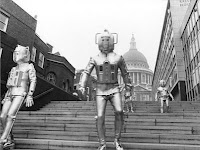See #45-41 HERE
See #40-36 HERE
35. The Hungry Earth/Cold Blood
Matt Smith's first year as the Doctor brought many a great story, but my personal favorite was this great two parter reintroducing the Silurians. Their look is completely refreshed, yet you can see the same story themes from their original appearance in Doctor Who and the Silurians. Add to that a top performance from Matt Smith, and you've got a modern classic!
 34. Mindwarp
34. MindwarpThe second part of the year-long Trial of the Time Lord season, Mindwarp is that year's most innovative episode. Bringing back the popular, evil Sil from Vengeance on Varos, and boldly presenting Colin Baker at his most unlikeable yet. What really makes this story though is Peri's tragic end where her body is taken over for good. Nicola Bryant gives one of the most haunting performances ever in Doctor Who.
 33. The Mark of the Rani
33. The Mark of the RaniMost people aren't too fond of Colin Baker's time as the Doctor. Yet I think his first season contained 5 great stories and just one dud (Timelash, duhhh). The Mark of the Rani is one of the good ones, introducing a new evil Time Lady, the Rani, who wants nothing more than to conduct her experiments in peace, but with the interfering Master about, she can't help but get involved. This story also has one of my favorite Doctor Who scores ever.
 32. Spearhead from Space
32. Spearhead from SpaceSpearhead from Space ushered in a whole new era for Doctor Who. The show was now in color, it was Jon Pertwee's first episode, and the show was now entirely based on Earth. Writer Robert Holmes masterfully brought the menace right into our world, with shop window dummies attacking people on the streets. This was the start to one of my favorite times eras of Doctor Who.
31. The Robots of Death
The Robots of Death holds a special place in my heart, for it was the first classic episode of Doctor Who I ever saw. And it was a good one to start with, as this is the quintessential Tom Baker story. Evil robots running amuck, a whodunnit? scenario, and loads of interesting characters and story development. A scantily clad Leela doesn't hinder the show either! :P























